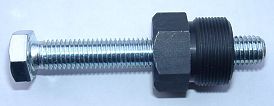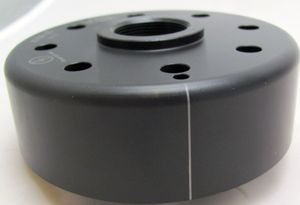Powerdynamo regresa el encendido
y la luz
a su moto clásica
|
|
Powerdynamo regresa el encendido |
|
|||
|
¡Apesadumbrado! |
versión 29.10.2010 |
|
|
Por favor lea primero las instrucciones completamente antes de empezar con la instalación o la modificación de las piezas. Tenga en cuenta las llamadas de atención en la página de informaciones para el sistema. |
| Si no tenga conocimientos técnicos para la instalación, entonces por favor deje realizarla de una persona cualificada o de un taller técnico correspondiente. Una instalación inadecuada causa daño tanto en el nuevo sistema como en la motocicleta. | |
| Antes de pedir el sistema, por favor comprueba mediante la lista de paquetes (o bien la foto
"piezas en volumen de entrega") si la herramienta recomendada de nosotros para
extraer el rotor (extractor) está contenida en el volumen de
entrega. En caso negativo por lo mejor pídala también directamente.
¡En caso de daño al rotor por usar otros herramientas y medios (inadecuados), el derecho de garantía
prescribe! Cuando un rotor está sentado demasiado bajo (por cualquier causa), toca y destruye la unidad de estator que está debajo. |
|
| Si tiene acceso a Internet, vea esta documentación en línea. Puede ampliar los imagenes por cliquear sobre ellos y entonces recibe más
informaciones. Lista del sistema en: http://www.powerdynamo.biz |
|
|
|
El rotor es muy sensible a efectos de golpes (por ejemplo mientras el transporte). |
| Compruebe en cada caso antes de la instalación de la pieza el estado fijo de los magnéticos por intentar apartarlos con los dedos al
lado. Después de efectos de golpes, algunos de los magnéticos pegados podrían haberse soltados y podrían estar fijándose solamente por su poder magnético que resultaría en daños graves en el dispositivo mientras el funcionamiento. Al mismo tiempo, por favor comruebe los magnéticos del rotor por cuerpos extraños (por ejemplo tornillos u otros objetos metállicos). |

|
Estas partes las debe haber recibido:
|
 |
Para retirar el nuevo rotor necesita un extractor M27x1.25
(Número de partes: 99
99 799 00 -No
en el alcance de la fuente!-).
ATENCIÓN: ¡Al usar un extractor de garras se sueltan los imanes en el rotor! |
|
|
|
|
|
|
| Please note: If you drive the motorcycle with this system without battery (which is no problem for the system itself) AND use side indicators and/or electronic equipment you will have to install a large capacity condenser or opt for an alternative regulator with build in condenser to smoothen the frequency of the voltage. | |
|
|
|
| Make sure your motorcycle rests securely on her stand, preferably on an elevated work bench and that you have good access to the generator side of the engine. | |
|
|
|
 |
Disconnect all wires from the old magneto, the ignition coils, the rectifier and the regulator and remove these parts. |
|
|
|
 |
Take the woodruff key from the crank. You will not need it anymore. Please do not forget to do so, otherwise you will have trouble later on in the assembly. (Remark: This woodruff key does not actually hold your rotor on the shaft, this is done by the cone. It simply guides to the correct setting which will now be otherwise achieved.) |
|
|
|
 |
Contrary to our policy of no changes on engine casing, you have to
do a little modification at your engine.
You will need a little opening in direction to the cable exit at the generator support (drill a 10mm hole and cut in from above)! |
|
|
|
 |
Have a look at the new stator. You will find there a small red marking somewhat
near the cable exit. This is an ignition marking.
Don't remove the stator from its base place, it is needless and you're only in risk of damaging the coils and wires.
(Photo shows similar stator unit!) |
|
|
|

|
Put the stator unit onto the generator case. Lead the cable through the newly made opening and fasten the plate by using the 3 supplied screws M5. There is a rubber grommet on the stator wire. Press it into the wire exit opening and than cut the surplus material off carefully.
(Photo shows different motorcycle!) |
|
|
|
 |
Have a look at the new rotor. You will find on its circumference a small pressed in line. That is an ignition marking. It is durable, but not well visible, so better highlighten it with some marker pen. The rotor might have an arrow pointing clockwise. This is no problem, important is that the stator is made for anticlockwise turning systems, such as this Suzuki. |
|
|
|

|
The rotor is missing 3 magnets 120 degrees apart. This is wanted and not a defect, those magnetic holes trigger ignition.
To get maximum flexibility no groove has been put into the rotor. No
need to worry over the now lost woodruff key. It did not have an
arresting capacity, it was guiding to correct ignition settings. Now
you have the markings and a much greater flexibility. Remove the spark plugs. Place the rotor loosely onto the crank and check that it may move freely above the statorbase. Please check this very carefully. Repaired shafts sometimes are slightly shorter and the rotor might touch the coils, destroying them soon. |
|
|
|
 |
Bring one of the pistons into ignition position (consult the owner's
manual). You
could move the piston by putting the rotor loosely onto the crank
shaft and turning it. Please do bear in mind hat your Suzuki turns
anti-clockwise. So you have to turn the rotor clockwise for reaching the ignition point
after you had TDC.
Once you have found the correct ignition point, take the rotor carefully off again without changing the crank's position and reset it onto the crank in such a way that the marking on the rotor aligns with the marking on the stator. Take care not to change the crank's (ignition) position. Otherwise you have to redo this procedure. |
|
|
|
 |
In that position fasten the rotor carefully with the original screw. Screw-in the spark plugs again. |
|
|
|
 |
Put on the engine cover and fasten it. Finally you have to mount the 3 ignition coils, the regulator/rectifier and the relay at an convenient place on your motorcycle. Connect the parts to each other as described below. The integration (connection) of the new system to the rest of the motorcycle electrics (lights, horn) is made at the battery or where the battery would be, if you want to drive without.
(Photo shows Suzuki GT750!) |
|
|
|